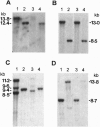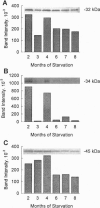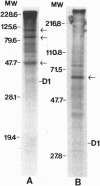Abstract
The marine slug Elysia chlorotica (Gould) forms an intracellular symbiosis with photosynthetically active chloroplasts from the chromophytic alga Vaucheria litorea (C. Agardh). This symbiotic association was characterized over a period of 8 months during which E. chlorotica was deprived of V. litorea but provided with light and CO2. The fine structure of the symbiotic chloroplasts remained intact in E. chlorotica even after 8 months of starvation as revealed by electron microscopy. Southern blot analysis of total DNA from E. chlorotica indicated that algal genes, i.e., rbcL, rbcS, psaB, psbA, and 16S rRNA are present in the animal. These genes are typically localized to the plastid genome in higher plants and algae except rbcS, which is nuclear-encoded in higher plants and green (chlorophyll a/b) algae. Our analysis suggests, however, that similar to the few other chromophytes (chlorophyll a/c) examined, rbcS is chloroplast encoded in V. litorea. Levels of psbA transcripts remained constant in E. chlorotica starved for 2 and 3 months and then gradually declined over the next 5 months corresponding with senescence of the animal in culture and in nature. The RNA synthesis inhibitor 6-methylpurine reduced the accumulation of psbA transcripts confirming active transcription. In contrast to psbA, levels of 16S rRNA transcripts remained constant throughout the starvation period. The levels of the photosystem II proteins, D1 and CP43, were high at 2 and 4 months of starvation and remained constant at a lower steady-state level after 6 months. In contrast, D2 protein levels, although high at 2 and 4 months, were very low at all other periods of starvation. At 8 months, de novo synthesis of several thylakoid membrane-enriched proteins, including D1, still occurred. To our knowledge, these results represent the first molecular evidence for active transcription and translation of algal chloroplast genes in an animal host and are discussed in relation to the endosymbiotic theory of eukaryote origins.
Full text
PDF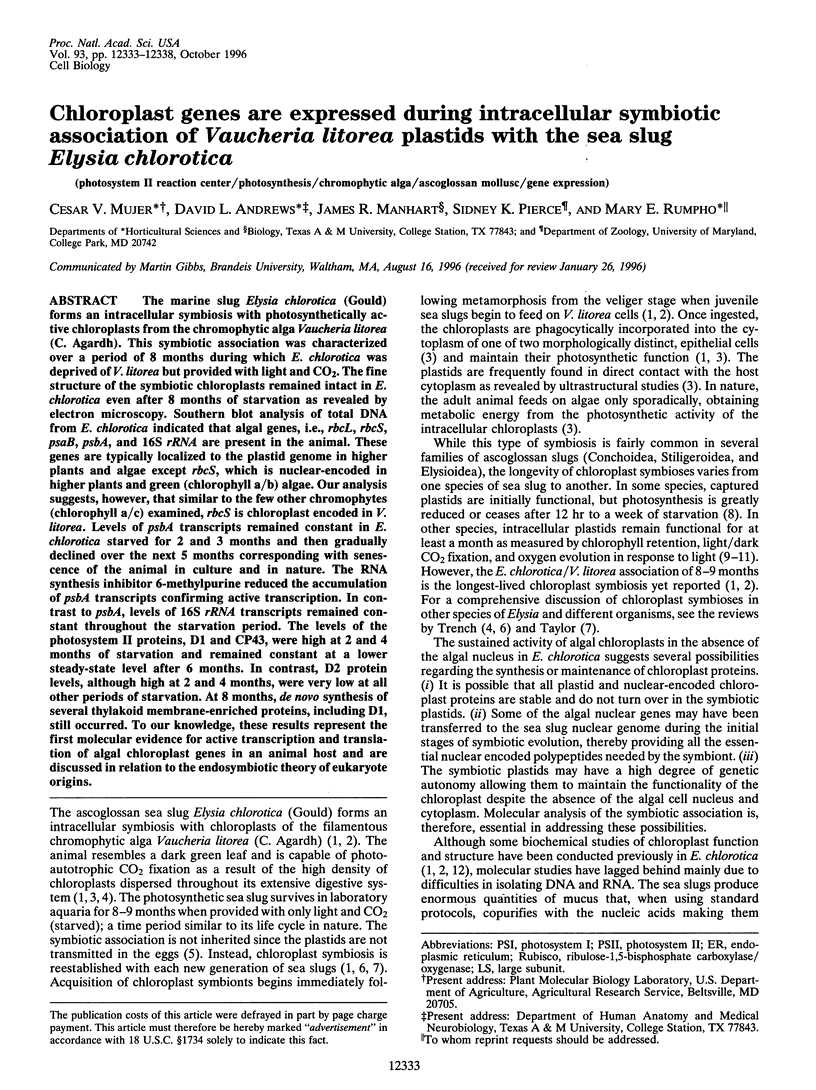
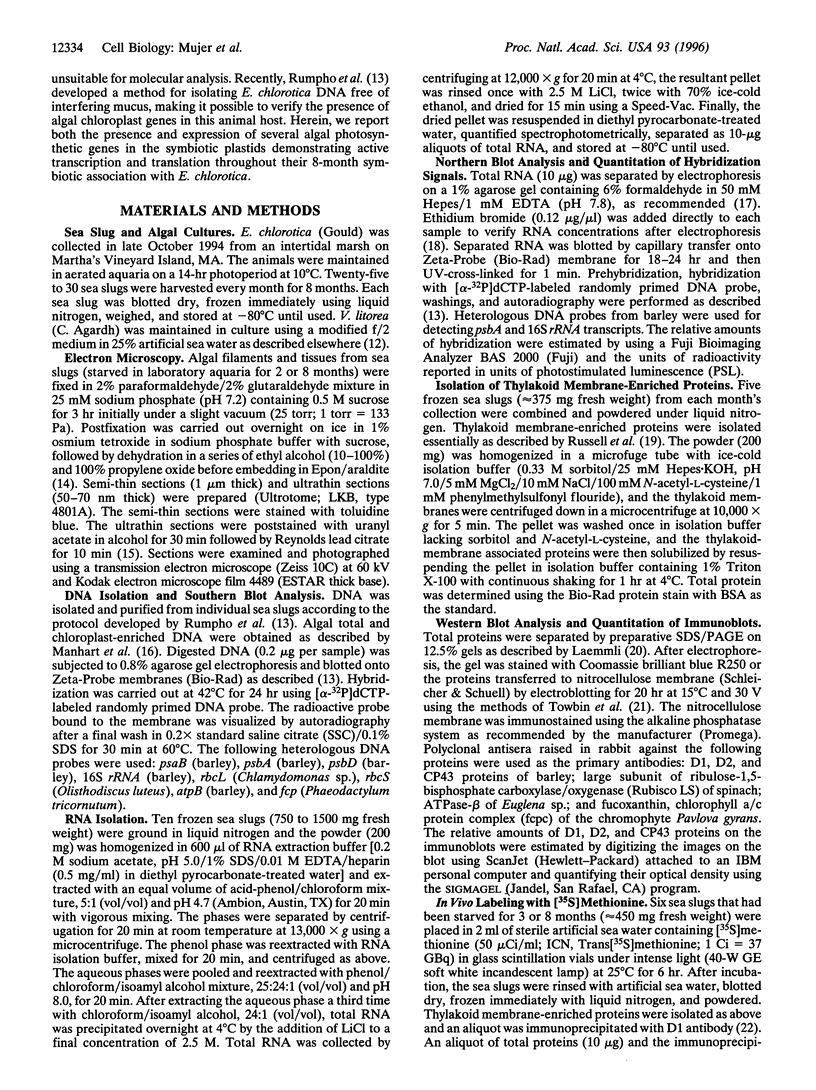
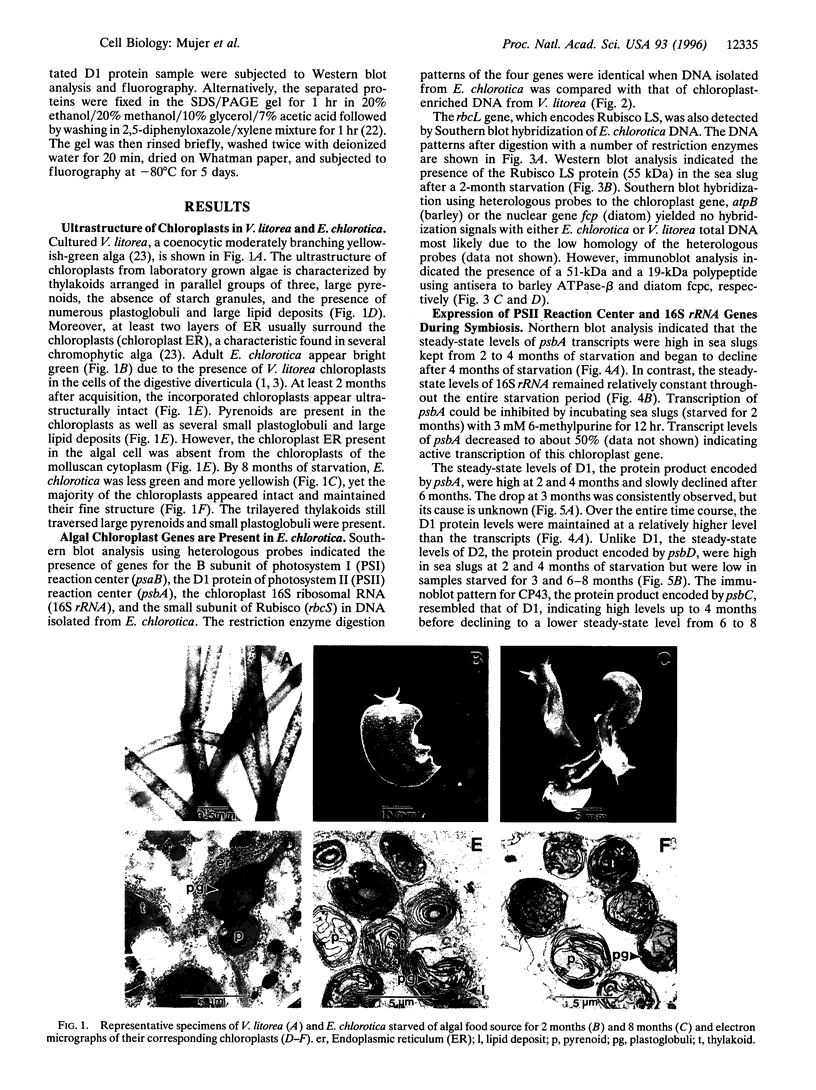
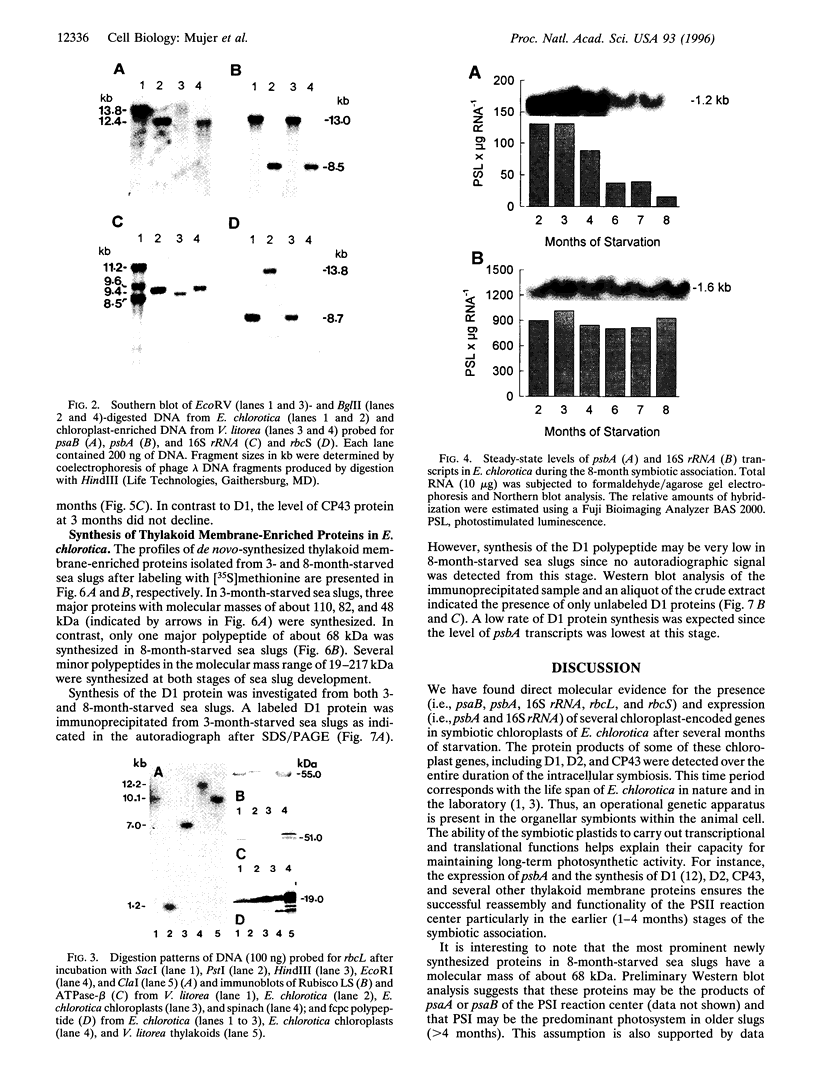
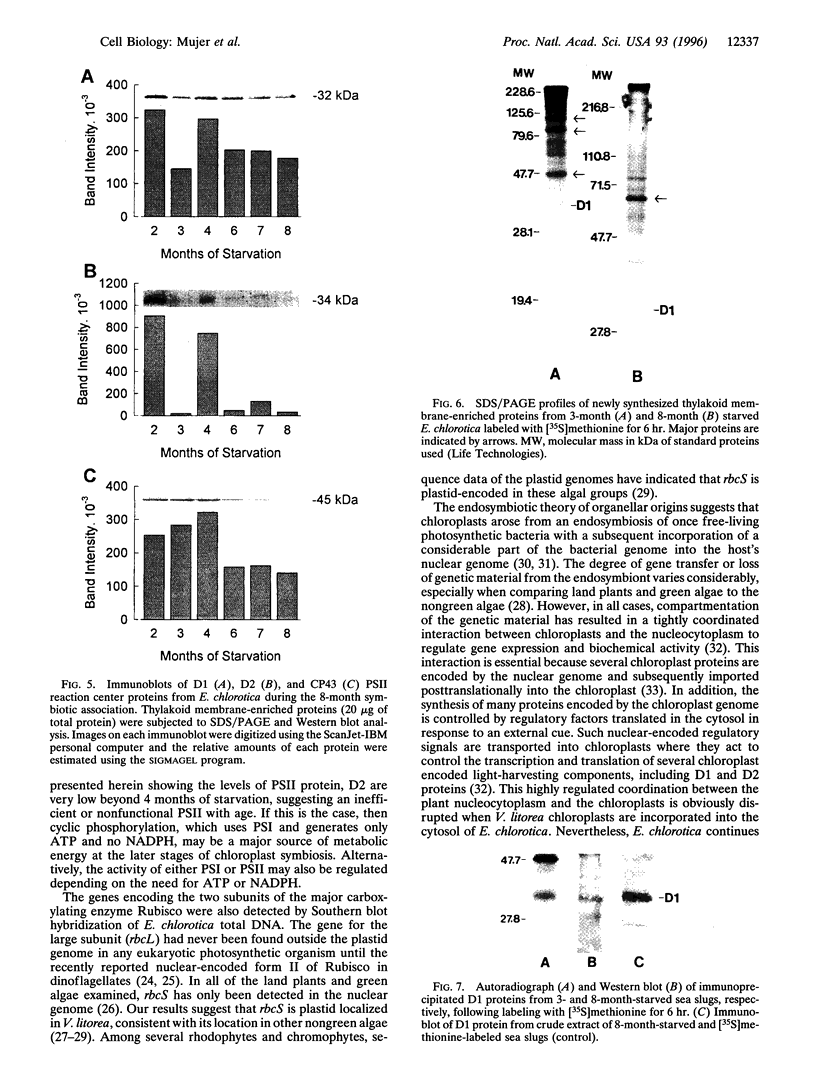
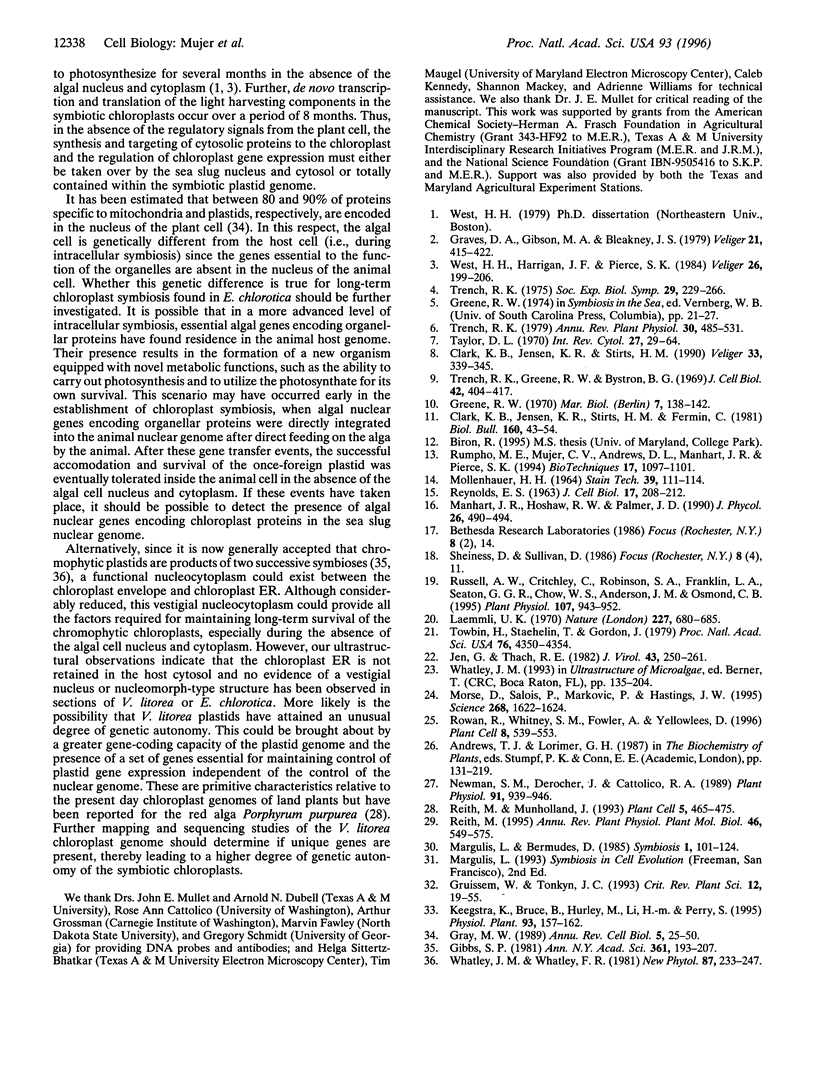
Images in this article
Selected References
These references are in PubMed. This may not be the complete list of references from this article.
- Gibbs S. P. The chloroplasts of some algal groups may have evolved from endosymbiotic eukaryotic algae. Ann N Y Acad Sci. 1981;361:193–208. doi: 10.1111/j.1749-6632.1981.tb46519.x. [DOI] [PubMed] [Google Scholar]
- Gray M. W. Origin and evolution of mitochondrial DNA. Annu Rev Cell Biol. 1989;5:25–50. doi: 10.1146/annurev.cb.05.110189.000325. [DOI] [PubMed] [Google Scholar]
- Jen G., Thach R. E. Inhibition of host translation in encephalomyocarditis virus-infected L cells: a novel mechanism. J Virol. 1982 Jul;43(1):250–261. doi: 10.1128/jvi.43.1.250-261.1982. [DOI] [PMC free article] [PubMed] [Google Scholar]
- Laemmli U. K. Cleavage of structural proteins during the assembly of the head of bacteriophage T4. Nature. 1970 Aug 15;227(5259):680–685. doi: 10.1038/227680a0. [DOI] [PubMed] [Google Scholar]
- MOLLENHAUER H. H. PLASTIC EMBEDDING MIXTURES FOR USE IN ELECTRON MICROSCOPY. Stain Technol. 1964 Mar;39:111–114. [PubMed] [Google Scholar]
- Margulis L., Bermudes D. Symbiosis as a mechanism of evolution: status of cell symbiosis theory. Symbiosis. 1985;1:101–124. [PubMed] [Google Scholar]
- Morse D., Salois P., Markovic P., Hastings J. W. A nuclear-encoded form II RuBisCO in dinoflagellates. Science. 1995 Jun 16;268(5217):1622–1624. doi: 10.1126/science.7777861. [DOI] [PubMed] [Google Scholar]
- Newman S. M., Derocher J., Cattolico R. A. Analysis of Chromophytic and Rhodophytic Ribulose-1,5-Bisphosphate Carboxylase Indicates Extensive Structural and Functional Similarities among Evolutionarily Diverse Algae. Plant Physiol. 1989 Nov;91(3):939–946. doi: 10.1104/pp.91.3.939. [DOI] [PMC free article] [PubMed] [Google Scholar]
- REYNOLDS E. S. The use of lead citrate at high pH as an electron-opaque stain in electron microscopy. J Cell Biol. 1963 Apr;17:208–212. doi: 10.1083/jcb.17.1.208. [DOI] [PMC free article] [PubMed] [Google Scholar]
- Reith M., Munholland J. A High-Resolution Gene Map of the Chloroplast Genome of the Red Alga Porphyra purpurea. Plant Cell. 1993 Apr;5(4):465–475. doi: 10.1105/tpc.5.4.465. [DOI] [PMC free article] [PubMed] [Google Scholar]
- Rowan R., Whitney S. M., Fowler A., Yellowlees D. Rubisco in marine symbiotic dinoflagellates: form II enzymes in eukaryotic oxygenic phototrophs encoded by a nuclear multigene family. Plant Cell. 1996 Mar;8(3):539–553. doi: 10.1105/tpc.8.3.539. [DOI] [PMC free article] [PubMed] [Google Scholar]
- Rumpho M. E., Mujer C. V., Andrews D. L., Manhart J. R., Pierce S. K. Extraction of DNA from mucilaginous tissues of a sea slug (Elysia chlorotica). Biotechniques. 1994 Dec;17(6):1097–1101. [PubMed] [Google Scholar]
- Russell A. W., Critchley C., Robinson S. A., Franklin L. A., Seaton GGR., Chow W. S., Anderson J. M., Osmond C. B. Photosystem II Regulation and Dynamics of the Chloroplast D1 Protein in Arabidopsis Leaves during Photosynthesis and Photoinhibition. Plant Physiol. 1995 Mar;107(3):943–952. doi: 10.1104/pp.107.3.943. [DOI] [PMC free article] [PubMed] [Google Scholar]
- Towbin H., Staehelin T., Gordon J. Electrophoretic transfer of proteins from polyacrylamide gels to nitrocellulose sheets: procedure and some applications. Proc Natl Acad Sci U S A. 1979 Sep;76(9):4350–4354. doi: 10.1073/pnas.76.9.4350. [DOI] [PMC free article] [PubMed] [Google Scholar]
- Trench R. K., Greene R. W., Bystrom B. G. Chloroplasts as functional organelles in animal tissues. J Cell Biol. 1969 Aug;42(2):404–417. doi: 10.1083/jcb.42.2.404. [DOI] [PMC free article] [PubMed] [Google Scholar]
- Trench R. K. Of 'leaves that crawl': functional chloroplasts in animal cells. Symp Soc Exp Biol. 1975;(29):229–265. [PubMed] [Google Scholar]




